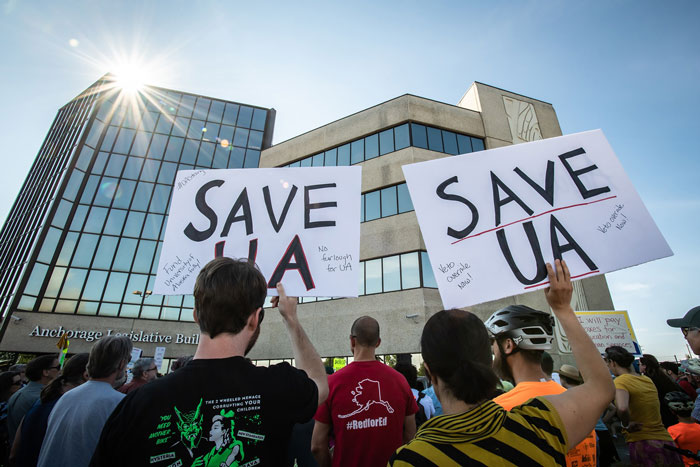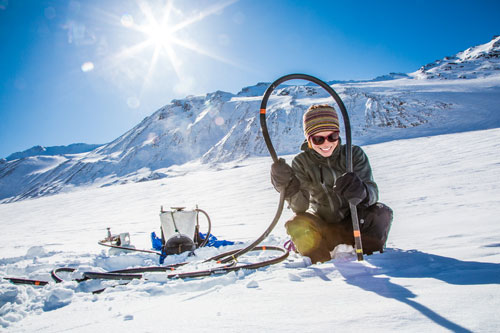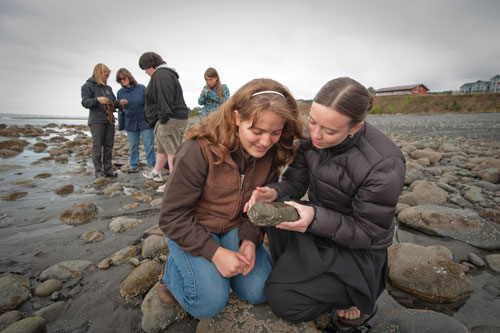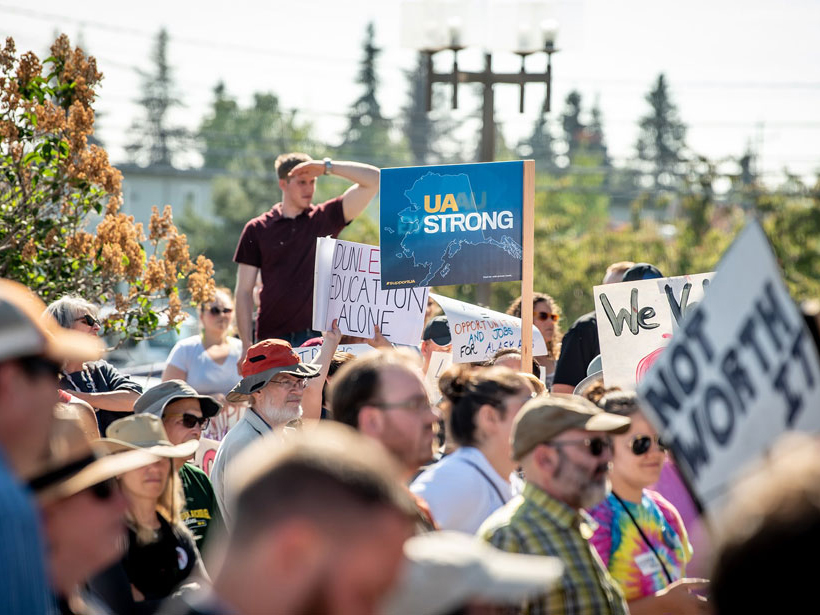Update: On 12 July, time ran out for the Alaska Legislature to override Gov. Mike Dunleavy’s vetoes to the state’s budget, including a cut of $130 million from the University of Alaska (UA). This Eos article, describing the forecasted impact to UA, was written after Dunleavy’s vetoes but before the deadline to override them ran out.
Alaska Governor Mike Dunleavy’s decision to slash the state’s funding for the University of Alaska by nearly 41% has the academic and research community up in arms. They are waging a nail-biter campaign to convince the state legislature to override what they say will be devastating and long-lasting damage to the university and the state, as well as to world-class research about the Arctic, climate change, and a host of other disciplines.
Dunleavy’s “draconian cut” of $130 million is “really stunning,” University of Alaska president James Johnsen told Eos.
Johnsen is spearheading an effort to restore the $322 million in state funding that the legislature approved for the current fiscal year that began on 1 July but that the governor vetoed on 28 June. That figure was already down from the $327 million the university received in the previous fiscal year.
If the budget cut is enacted, it “will strike an institutional and reputational blow [to the university] from which we may likely never recover.”
The university system’s entire annual budget is about $900 million, with other streams of revenue including tuition, research grants, and contracts, according to Johnsen.
The legislature could override Dunleavy’s veto decision during a special legislative session that begins today, 8 July, in Wasilla. An override requires 45 of the 60 members of the legislature. Johnsen said that threshold is “an extremely heavy lift” but that his team “is working very, very hard to make it happen.”
If the budget cut is enacted, it “will strike an institutional and reputational blow [to the university] from which we may likely never recover,” Johnsen wrote to the University of Alaska (UA) community on 28 June. The entirety of the reduction, he wrote, is targeted on the appropriation for the University of Alaska Fairbanks (UAF), University of Alaska Anchorage (UAA), and the university’s administrative unit that provides central services for the entire system. Johnsen told Eos that the cuts likely would result in fewer faculty, lower student enrollment, and reduced research and tuition revenues.

The budget crisis facing the university, social services, and other programs across the state is tied to Dunleavy’s determination to provide Alaskan residents with $3,000 through the state’s Permanent Fund Dividend (PFD). Since PFD’s initial dividend year of 1982, the largest previous payment was about $2,100.
Dunleavy “would rather give every Alaskan 3,000 bucks and let them spend it as they wish than provide funding for public broadcasting, Medicaid, homeless shelters, K–12, pre-K, [and] university education,” Johnsen told Eos, noting that the governor thinks that individuals make better decisions about their money than the government does. “I don’t think it’s good for our state, but that’s his whole philosophical view.”
The governor has ties to the libertarian Koch brothers and their conservative advocacy group, Americans for Prosperity, with that group’s Alaska chapter having sponsored the governor’s field hearings about the budget earlier this year, according to the Anchorage Daily News and the Center for Media and Democracy, a watchdog group based in Madison, Wis.
Chance for an Override?
Some political analysts think that as many as 40 state legislators may already be in favor of overriding the governor’s decision, but getting the remaining five votes will be difficult. One state legislator favoring an override is Rep. Grier Hopkins (D-Fairbanks). Hopkins told Eos that the effects Dunleavy’s decision would have on the university system “are immeasurable” and would spread across the state.
“A broad bipartisan coalition of state lawmakers adamantly opposes the governor’s lack of vision for Alaska’s economy and university system, and we will work together to achieve the three quarter vote needed to override” the governor’s “reckless” cuts, said Hopkins, whose legislative district includes UAF. Hopkins, the chair of the House Energy Committee, is a member of the Alaska House Majority, a 24-member coalition of Democrats, Republicans, and Independents that controls the House of Representatives. “We will do everything in our power to protect the important research that occurs every day at UA,” he said.
A Sad Day for Alaska
Fran Ulmer, a former UAA chancellor and former Alaska lieutenant governor, told Eos that Dunleavy’s cuts “are disastrous.” She said that the damage to the university, students, faculty, and staff will have long-lasting impacts on the future of the state. “It takes a long time to build up the university’s competency and public confidence in the excellent programs that have been developed [at the university]. It only takes one very unfortunate moment for the governor to destroy that with his red pen. A sad day for Alaska.”
“If we have to absorb the governor’s budget cuts, it will eventually devastate the university,” Larry Hinzman, UAF’s vice chancellor for research, told Eos. “It will take decades of return funding to recover.”

Hinzman pointed out that the university is a leader in environmental, climate change, and Arctic system research, as well as research on Arctic culture and social issues. He also noted that UAF produces more journal articles, and receives more citations, on the Arctic than any other institution in the world. Hinzman stressed that the university and its research are major contributors to Alaska’s economy and development.
One example of tangible economic benefits the university provides to the state is its research on permafrost, which is present in 80% of Alaskan land, according to Dmitry Streletskiy, president of the nonprofit U.S. Permafrost Association and associate professor of geography at George Washington University. In a 2 July letter to Alaska State Senate President Cathy Giessel, Streletskiy urged overturning Dunleavy’s veto.
“The proposed budget reductions, if implemented, would cause an irreversible impact on the training, engineering, and research capabilities that are required to sustain Alaska’s present and future economies.”
“The extraordinary knowledge base and human resources pertaining to permafrost that currently exist in Alaska are in large part the results of past and ongoing teaching and research faculties and facilities that exist on the Fairbanks and Anchorage campuses,” Streletskiy wrote. “The proposed budget reductions, if implemented, would cause an irreversible impact on the training, engineering, and research capabilities that are required to sustain Alaska’s present and future economies. This would come at a time when warming and thawing of permafrost is accelerating and related mitigation techniques are required. Maintaining the University’s ongoing contributions in engineering and science is critical to future economic development and resource management in Alaska.”
Mark Myers, former UAF vice chancellor for research and former director of the U.S. Geological Survey, told Eos that the budget cuts are upsetting because research in the Arctic is so important and the university’s efforts—through its programs and its national and international collaborations—provide a great vehicle to understanding the Arctic.
Myers added that Alaska is a resource-based economy that needs to diversify. “Well, if it wants to diversity into a knowledge-based economy, what leads that in Alaska is the university’s research and development and training of the students and developing their critical thinking skills and their research capacity.”
An Inopportune Time for Cuts
Other scientists at the university also spoke out strongly against the cuts.
Hajo Eicken, director of the International Arctic Research Center at UAF, said that the cuts not only are disruptive but are coming at an inopportune time for the state. In terms of environmental upheaval and socioeconomic shifts in a broader geopolitical context, Alaska is facing “some of the most substantial changes you are seeing within the U.S. or possibly even throughout the Arctic at the moment,” he told Eos.
“Alaska is at a major crossroads. Fifty years from now, 20 years from now, probably 10 years from now, the state likely will look very different than what it looks like today. The university is the only tool the state has to look into the future in a broad and educated informed way and help the state figure out what are our options. By enforcing these cuts, the legislature and people of Alaska are depriving themselves of that opportunity to look at these different options.”
Robert McCoy, director of the Geophysical Institute at UAF, said that the governor’s “devastating” cuts caught everybody by surprise. With interest in the Arctic increasing, “we are in a great place to assist federal agencies and other universities and internationally in Arctic and global change research,” he said. “This budget cut is really going to hurt.”
Alex Webster, a postdoctoral scholar at the Institute of Arctic Biology at UAF, added that the cuts would mean that the university will not be able to attract or retain bright young minds in the future.
“I fear for what Alaska will look like following the massive brain drain that is to ensue,” she told Eos. “The University of Alaska is a beacon of education, research, and innovation in what would otherwise be a mostly extraction-driven economy. It is a critical hub for global climate change research in particular. Everyone, from everyday Alaskans, to the international research community, will suffer if it is sent into the death spiral that these cuts are designed to create.”
Devastating Cuts for Research and for Students
United Academics, which represents about 1,200 full-time faculty at the university, has come out forcefully in opposition to the cuts.

United Academics president Abel Bult-Ito told Eos that the cuts “will decimate the ability for our faculty to continue their highly competitive research on climate change, Arctic processes, environmental, Earth, and space science, biomedicine, and many other fields. We are currently the world leader in Arctic research, but these cuts will most certainly not allow us to maintain this position. These cuts also would be devastating for our students. They will not know whether their degree program will be left standing, their prospects of finishing their degree will be uncertain, and enrollment will plummet. Why would students want to come to UA if their educational opportunities are severely cut and they do not know whether their program will still exist?”
“The irony is that this is an entirely manufactured budget crisis to dismantle public services and public education and kick Alaska back into the Dark Ages.”
Bult-Ito, who also is a professor of neurobiology and anatomy at UAF, said that university faculty “will fight tooth to nail to make sure that the harm done to our students will be as little as possible.”
The budget cuts, Bult-Ito added, are terrible for the university and represent “a dismantling of the state of Alaska” by harming residents across the state, including students, the young, and the elderly. “The irony is that this is an entirely manufactured budget crisis to dismantle public services and public education and kick Alaska back into the Dark Ages in which Alaska will be reduced to a resource extraction colony for multinational corporations that leaves workers and the people of Alaska begging for the scraps,” he said.
Next Steps
If the veto override efforts fail, the university’s board of regents has directed UA president Johnsen to prepare a plan for financial exigency by 15 July, which would permit the university to rapidly discontinue programs and academic units and start the process of removing tenured faculty, according to Johnsen’s 28 June letter to the university community.
If the override fails, Johnsen told Eos that the university is “going to do our best to fence off our super strong research institutes so that they are not impacted negatively.” He said that one criterion the university will use to evaluate programs will be a consideration of the return on state investment. Currently, $1 of state money put into research at the university generates $6 of nonstate funds, according to Johnsen.
The size of the budget cuts means tough challenges, Johnsen said. “Does one nickel and dime every one of our universities and close some community campuses?” Johnsen said. “Well, you can close all the community campuses and you get to about $30 million. You’ve got [about] another $100 million to go.”
Johnsen and others, however, hope the legislature overrides the governor’s budget cuts. “You’re not going to have a great state without a great university,” Johnsen said.
—Randy Showstack (@RandyShowstack), Staff Writer
9 July 2019: This story has been updated to correct the name of Alaska State Senate President Cathy Giessel.
Citation:
Showstack, R. (2019), University of Alaska faces budget crisis, Eos, 100, https://doi.org/10.1029/2019EO128123. Published on 08 July 2019.
Text © 2019. AGU. CC BY-NC-ND 3.0
Except where otherwise noted, images are subject to copyright. Any reuse without express permission from the copyright owner is prohibited.
Text © 2019. AGU. CC BY-NC-ND 3.0
Except where otherwise noted, images are subject to copyright. Any reuse without express permission from the copyright owner is prohibited.

